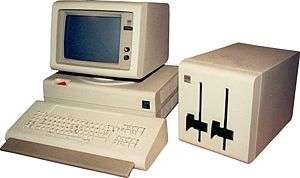IBM Displaywriter System
The IBM Displaywriter System 6580 was a dedicated microcomputer-based dedicated word processor that IBM's Office Products Division introduced in June 1980.[1][2] The system consisted of a central processing unit, based on the Intel 8086, in a desktop case, a monochrome CRT monitor atop the CPU, a detached keyboard, a detached dual disk drive that used 8-inch floppy disks, and a detached daisy wheel printer. The system booted from an 8-inch floppy disk that stored IBM's internally developed word processing software. The operator stored the "documents" (i.e., data files) on additional diskettes.
 IBM Displaywriter with keyboard, monitor and dual 8-inch floppy disk drive | |
| Developer | IBM |
|---|---|
| Manufacturer | IBM |
| Type | microcomputer |
| Release date | June 1980[1] |
| Introductory price | US$7,895 (equivalent to $24,498 in 2019) / leased for US$275 a month. |
"A basic system — consisting of a display with a typewriter-like keyboard and a logic unit, a printer and a device to record and read diskettes capable of storing more than 100 pages of average text — cost $7,895 and leased for $275 a month."[1] The basic word-processing software was Textpack E, with simple mail merge; Textpack 2 added support for double-sided disks, networking, spellchecking, and print spooling; Textpack 4 added automatic hyphenation, columns, and more sophisticated merging; and Textpack 6 added automatic footnoting and outlining. Other options included multilingual dictionaries, graphics, and reports.[3]
The Displaywriter's features were comparable to other word processors of its era. The features included mail-merge, with fields designated as a01, a02, a03, etc. Elementary arithmetic could be applied to the fields.
The basic Displaywriter was a standalone system. An optional central storage and management unit was available, which permitted multiple Displaywriters to share storage and a printer.
UCSD p-System[4][3] operating system and CP/M-86[5][6][7] were available for the Displaywriter System but were not its regular Operating System.
Connections to other IBM systems included:
- IBM 3278 emulation program[3] to attach to IBM 3274/3276 controllers, IBM 4321/4331, or IBM 4701.
- IBM 3277 emulation program to attach to IBM 3271, 3272 or 3274 controllers.
- Connection to IBM 8100 systems which use DPCX/DOSF.
Because of Displaywriter's popularity, IBM later produced DisplayWrite software for the IBM Personal Computer, with a similar user interface and equivalent to Textpack 4.[2]
References
- "IBM Displaywriter". IBM Archive. Retrieved 2009-01-31.
- Dickinson, John (1984-09-18). "IBM's Displaywriter Begets a Family of PC Software". PC. p. 238. Retrieved 29 January 2015.
- Dickinson, John (1984-09-18). "The Prototype: Displaywriter". PC Magazine. pp. 242–243. Retrieved 9 March 2016.
- SofTech's new products extend p-System's versatility. Info World. 1982-09-20. Retrieved 2010-02-25.
- "Digital Research Has CP/M-86 for IBM Displaywriter" (PDF). Digital Research News - For Digital Research Users Everywhere. Pacific Grove, California, USA: Digital Research, Inc. 1 (1): 2, 7. November 1981. Fourth Quarter. Retrieved 2020-01-18.
- CP/M-86 IBM displaywriter reference manual. Digital Research. 1981.
- Libes, Sol (December 1981). "Bytelines". BYTE. pp. 314–318. Retrieved 29 January 2015.
External links
